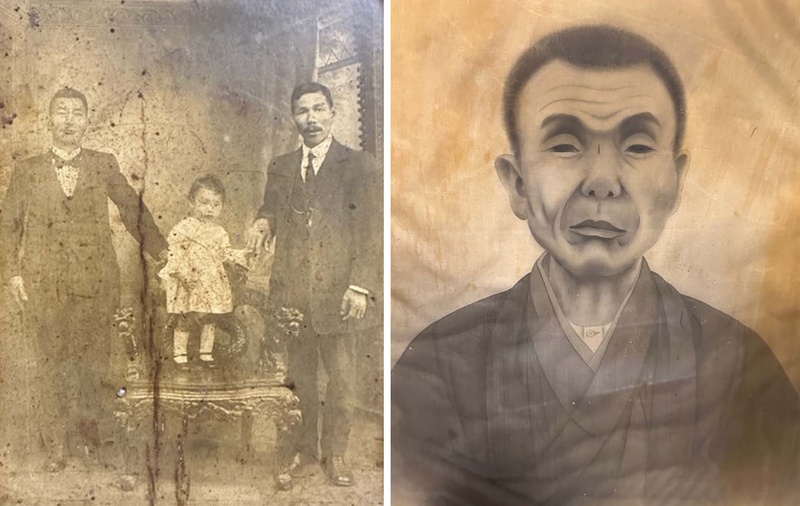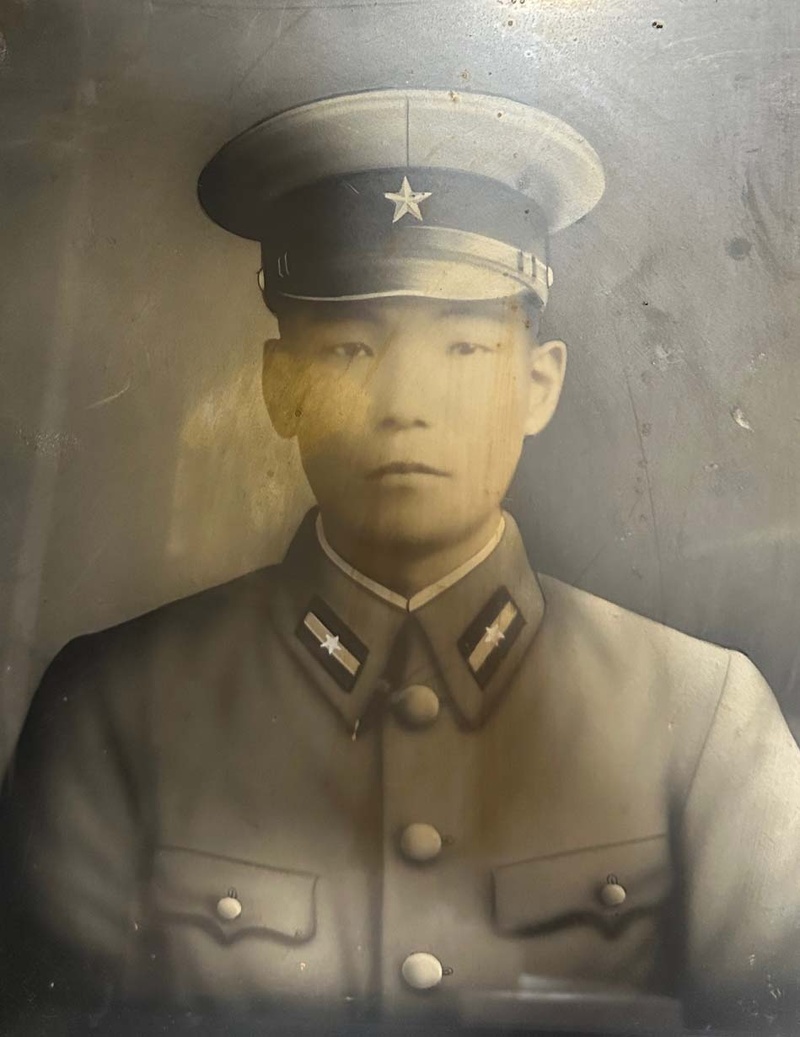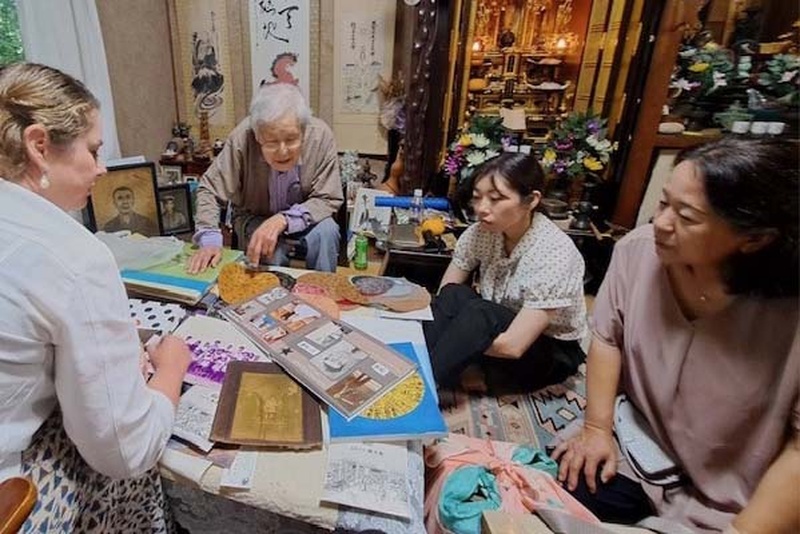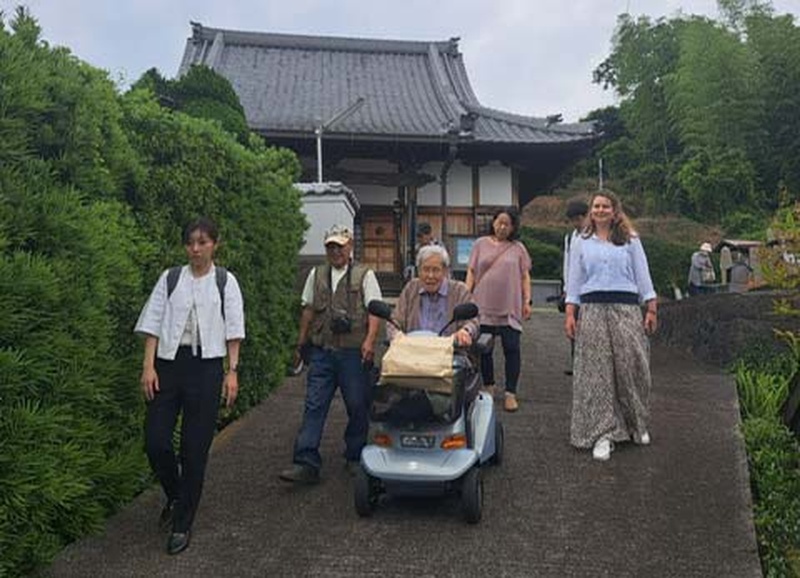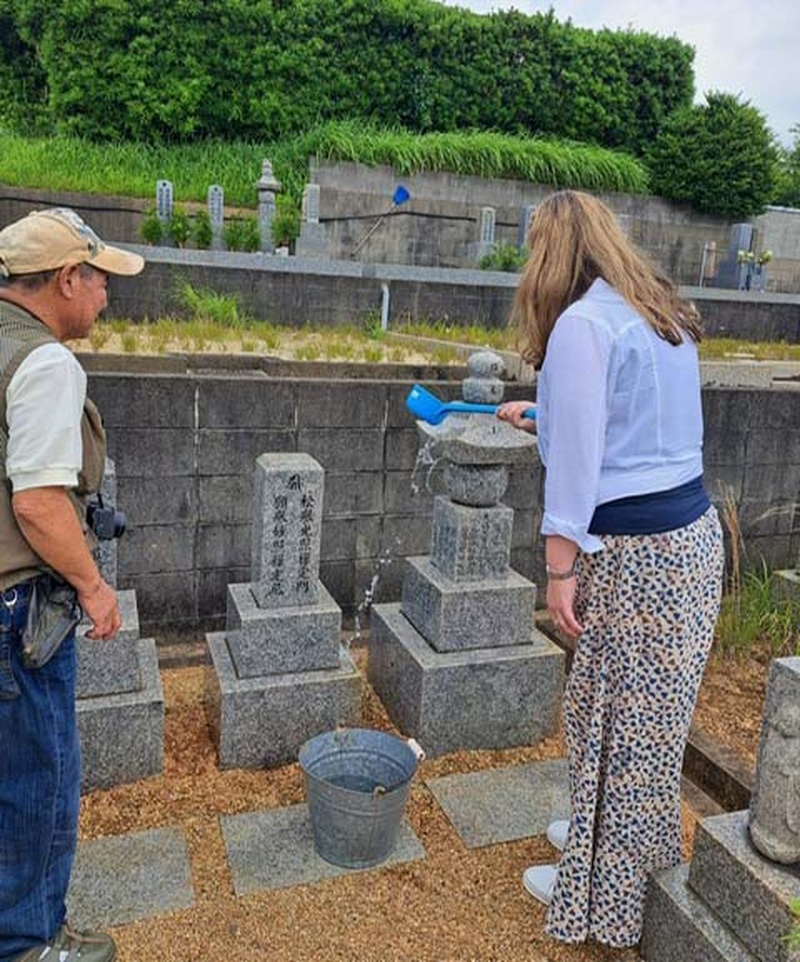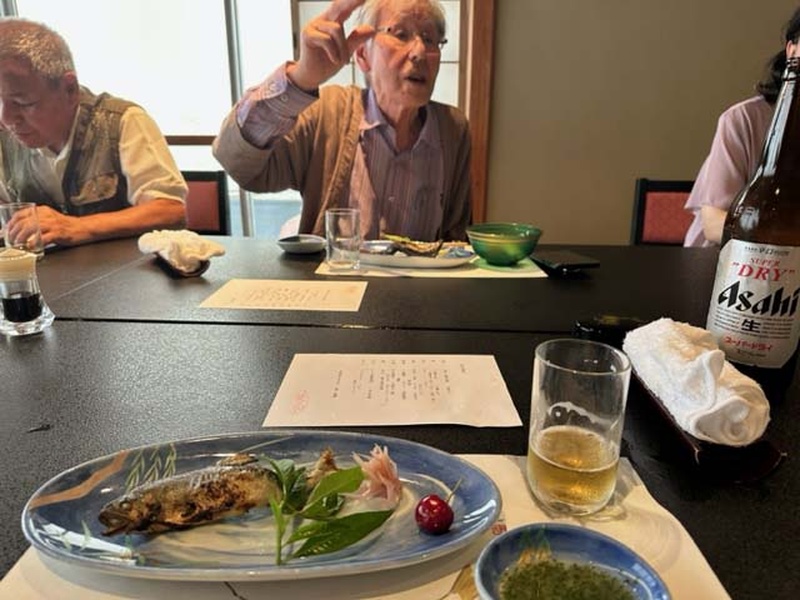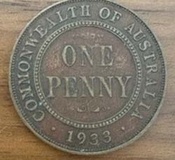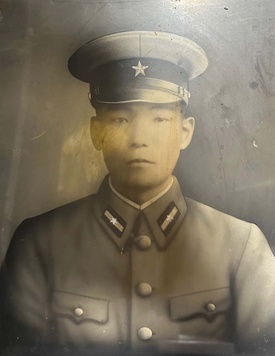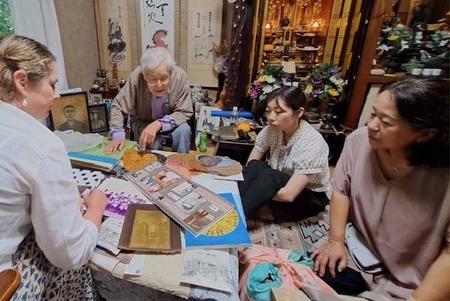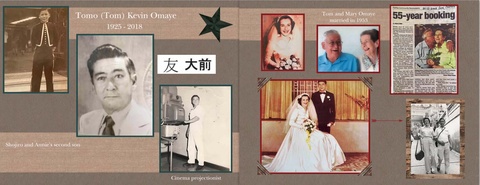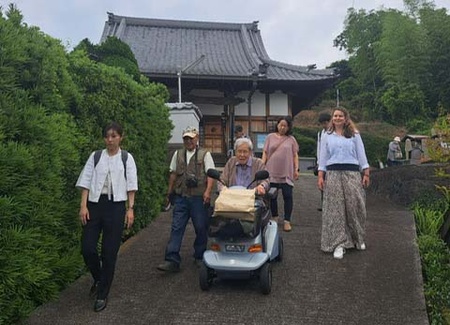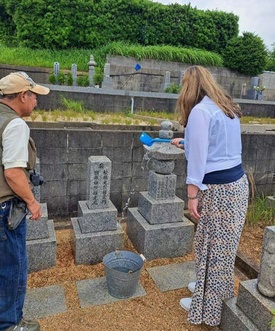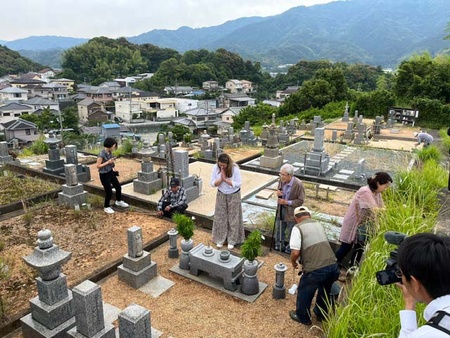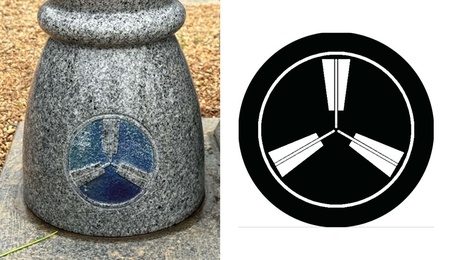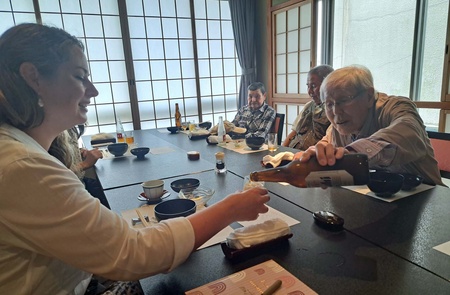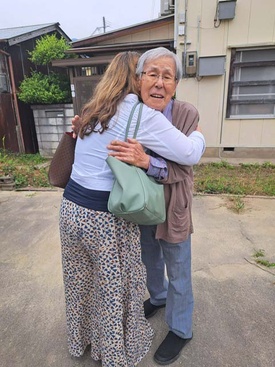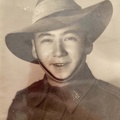Sharing stories, photos, and gifts
Junichi-sama brought us to a room he’d specially prepared for our meeting, with pictures of his father and grandfather set up. He produced a photograph of my great-grandfather, Shojiro, and his daughter, Aya, with another unknown man. I had never seen this photo before, but instantly recognised my great-grandfather. He looked smart with his large moustache and neat three-piece suit.
Junichi-sama also showed me a portrait of his grandfather, Matsuzaburo, who was my great-grandfather Shojiro’s brother. It turns out there were five children in the family. This was a revelation. We always wondered whether Shojiro had any siblings.
The TV producer asked me why my great-grandfather went to Australia. I said I didn’t know for sure. The producer suggested maybe at that time in Wakayama it was difficult to raise a large family so he went to Australia to earn money for the family.
I gave Junichi-sama a penny from Shojiro’s coin collection. My daughter had carefully cleaned it with vinegar and salt to bring back its shine. The coin was dated 1933, the year Junichi-sama was born.
I also gave his brothers Masaitsu and Shozo coins from Shojiro’s collection. Masaitsu received a 1941 coin for the year he was born.
Masaitsu’s mother, Tsuneko, was pregnant with him when his father, Tomizo, died in Papua New Guinea in WWII. Junichi-sama was then just eight years old. Coincidently, my grandfather and his brother were also deployed to Papua New Guinea around a year later, but with the Australian Army.
Junichi-sama visited Papua New Guinea twice by invitation from the Australian government to visit the memorial to his father. He proudly showed me photos of the Japanese memorial there, right next to the Australian memorial.
He had also visited Brisbane on the way, and showed me photos of a waterfall he remembered admiring. He said he had wondered whether he would find any of Shojiro’s family while visiting Australia, but he didn’t speak English, so he never found us.
Shozo, Junichi-sama’s other brother, was born in 1937. But due to the abdication of King Edward VII that year and the halting of printing the king on the Australian penny, that specific coin is extremely rare and our family did not have one. So I gifted Shozo a 1938 penny instead.
The brothers also had three other siblings who had all passed, including a sister who died when she was only three months old. The family still has her hina doll in remembrance.
Junichi-sama allowed me to choose one of his paintings to bring home, as well as some beautiful lacquerware which is famous in Kainan, and a famous painting of Kyoto on fabric. Masaitsu and his family also gifted me some pottery, more lacquerware, a fan, and more. They were so very generous. Masaitsu explained they were having a lacquerware tray made for me that included our family crest. I was so moved.
I made a photo book for Junichi-sama and surprised him with it. I had spent the few weeks prior to this visit updating the family tree with more old family photos relatives had sent me that I hadn’t seen before.
The last time I had seen most of my extended family in Australia was at my grandfather’s (Pop Tom) funeral in 2018, so meeting Junichi-sama was a great opportunity to connect with them again and also meet new family members I didn’t even know existed. I wanted to make sure everyone knew about this revelation so I could share it with them all.
The photo book I made was full of family tree diagrams, old photos, quotes, memories, and more. Junichi-sama and his family smiled hearing our stories, especially of how my great aunt Yuki sucked red belly black snake venom from my mum’s leg when she was a child and saved her life!
I also created a video of family members’ messages to Junichi-sama from all around Australia. I included a map of where we are located and a link to Shojiro so he could see in a diagram how we are all related without the need for English descriptions.
In the video, the family members attempted to greet Junichi-sama in Japanese, which I think the Japanese Omae family appreciated! My three-year-old nephew whose middle name is Shojiro made them all laugh with his attempt to pronounce konnichiwa: “Ichiwa, Ichiwa…KONichiwa”.
Prayers to our ancestors
Junichi-sama asked if I would like to pray to our ancestors at the family altar, and he chanted a prayer while I kneeled beside him. He was very kind, showing me where to put the incense and telling me what to say. I took my time giving thanks for this moment.
Next it was time to visit the Omae family cemetery at the top of the mountain in Kainan City. Junichi-sama jumped on his electric scooter and zoomed off up the road.
We all followed and along the way. Masaitsu-sama showed us various houses his family had lived in and a vacant plot of land where their old house burned down.
As we walked through the streets and passed neighbours it was surreal hearing people say, “Konnichiwa Omae-san,” my mother’s maiden name.
I asked Junichi-sama if he knew where my great-grandfather had lived, and said he had lived in a house close to the mountain on the edge of Kainan, but unfortunately it was no longer there.
We trekked up to the cemetery. Junichi-sama said it was his first visit in three years as he found walking increasingly difficult. I appreciated the effort he made so we could have this moment together.
Masaitsu-sama showed me how to wash the gravestones and I poured water over the top of them, watching as the water peacefully cascaded over each pillar of the stone. I placed incense in the holder and we prayed again while Junichi chanted. It was one of the most special moments of the day.
The view from the cemetery was incredible. The mountains were misty and it felt like such a profound moment to be all there together. I was so grateful Junichi had struggled up the mountain for this.
Junichi-sama showed me the Omae family crest, which was engraved on the cemetery ornaments: three fans symbolising suehirogari, the opening of a fan to a bright future.
Junichi-san explained my great-great grandmother was from the Tamaki family in Gobo, Wakayama and her father was the village headman. Next time we meet we plan to go to Gobo together.
A Kaiseki to remember
Junichi-sama declared it was time to eat, so we drove to a 90-year-old building in town. There, we climbed the three flights of stairs: I held onto Junichi-sama’s arm as we climbed – not that he needed it! He was full of energy that day. We arrived in a private room with a long table and chairs set beautifully.
He explained how he had visited a few restaurants to check the best place for our reunion lunch. The restaurant he’d chosen was absolutely perfect.
He ordered me a beer to celebrate, even though he does not drink alcohol. It was a very sweet moment when he leaned across the table to fill my glass.
See you soon, not goodbye!
We ended the day back at Junichi-sama’s house, where Masaitsu’s daughter, Azusa Ueda, was also waiting to meet us. We talked and shared more stories until it was time to leave.
I will be returning to Kainan with my immediate family in October for the Wakayama Kenjinkai Conference, which made the goodbyes slightly easier.
Instead of bowing goodbye, Junichi-sama held out his hand to shake mine. We both had teary eyes again, and in Aussie style I gave him a big hug, which he welcomed. It was a really lovely moment.
As I turned to leave, I saw a neighbour clapping, and she continued to clap while I said goodbye to everyone, even as we drove away waving.
All day I kept thinking, if only my pop were here, he would love this moment so much. After I shared all this info with my extended family later on, they all told me Pop would be so proud. Even though he’s no longer with us, I’m happy to say his wish was finally fulfilled.
Now I use google translate to communicate with my new-found family via a messaging app. And finding them has inspired me to try harder to learn Japanese.
Lastly, a huge thank you to the members of Nikkei Australia. Without this group, I never would have been able to find my relatives. Arigatou Gozaimasu!
All photos are courtesy of the author.
*This article was originally published in Nikkei Australia on July 4, 2023.
© 2023 Shey Dimon



